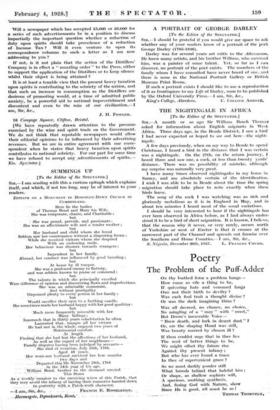SUMMINGS UP
[To the Editor of the SPECTATOR.]
Sm,—I am sending with this a curious epitaph which explains itself, and which, if not too long, may be of interest to your readers.,
EPITAPH ON A -MONUMENT IN HORSELEY-DOWN CHURCH IN CUMBERLAND.
Here lie the bodies of Thomas Bond and Mary his Wife. She was temperate, chaste, and Charitable : but
• She was proud, peevish, and passionate : She was an affectionate wife and a tender mother ; but Her husband and child whom she loved Seldom'saw her countenance without a disgusting frown : -While she received visitors whom she despised With an endearing smile. Her behaviour was discreet towards strangers : but Imprudent in her family. Abroad, her conduct was influenced by good breeding ; but At home by ill temper. She was a professed enemy to flattery, and was seldom known to praise or commend : but The talents in which she principally excelled Were difference of opinion and discovering flaws and imperfections. She was an admirable economist, And without prodigality Dispensed plenty to every' person in her family : but Would sacrifice their eyes to a farthing candle. She sometimes made her husband happy with her good qualities : but Much more frequently miserable with her -
- Many failings ; ' Insomuch that in thirty years cohabitation he often Lamented that, maugre all her virtues He had not in the whole; enjoyed two years of Matrimonial comfort.
At length „ • . Finding that she had lost the affections of her husband,
As well as the regard of her neighbours—
Family disputes having been indulged by servants— ' She died of vexation, July 26th, 1768.
Aged 48 years. Her worn-out husband survived her four months
' two -days and
... -Departed this life November 28th, 1768 in the 54th year of his .age.
William Bond, brother to the deceased erected . This Stone
As a weekly-monitor to the surviving wives of this Parish, that they may avoid the infamy of having their memories handed down • to posterity with a Patch-work character.
—I. am, &C„ - FRANCIS E. ROOHLEDSE. _ Heronsgate, Difinctlureh, Kenf.- A PORTRAIT OF GEORGE DARLEY
[To the Editor of the SPECTATOR.]
SIR,—I should be grateful if you would give me space to ask whether- any of your readers know Of a portrait of the poet George Darley (1795-1846).
Darley was for- several years art critic to the Athenaeum. He knew many artists, and his brother William, who survived him, Was a painter of some talent. Yet, so far as I can discoVer, no portrait of the poet exists. The members of the family whom I have consulted have never heard of one,' and there is none in the National Portrait Gallery or British Museum Print Room.
If such a portrait exists I should like to use a reproduction of it as frontispiece to my Life of Darley, soon to be published by the Oidord University Press.—I am, Sir, &c., King's College, Aberdeen. C. COWER ARBOrr.
THE NIGHTINGALE IN AFRICA
[To the Editor of the SPECTATOR.]
Sin,—A month or so ago Sir William Beach Thonio8 asked for information about English migrants in West Africa. Three days ago, in the Beude District, I saw a bird I had never expected or hoped to see out here—the night- ingale.
A few days previously, when on my way to Beude to spend Christmas, I heard a bird in the distance that I was certain was a nightingale. On the 27th, on the return journey, I heard three and saw one, a cock, at less than twenty yards' distance. There was no possibility of mistake, although my surprise was naturally very great.
I have many times observed nightingales in my home in Surrey, and am absolutely certain of the identification. I wish I was able to be in Beude about the time the spring • migration should take place to note exactly when these birds leave.
The song of the cock I was watching was as rich and gloriously melodious as it is in England in May, and in about ten minutes I heard most of the usual variations.
I should be very interested to hear if the nightingale has ever been observed in Africa before, as I had always under- stood it to be a bird of short migration. It is known, I believe, that the reason why it never, or very rarely, occurs north of Yorkshire or west of Exeter is that it crosses at the narrowest part of the Channel and spreads out fanwise over the Southern and Home Counties.-1` am, Sir, &c., S. Nigeria, December 30th, 1927. L. FRANCES CHUBB.






































 Previous page
Previous page